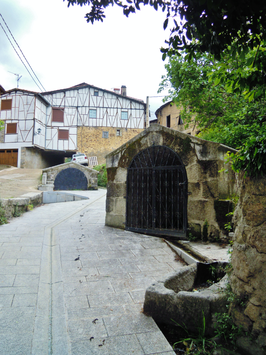San Esteban de la Sierra
San Esteban de la Sierra (Santisteban or simply only San Esteban in local dialect) is a village and municipality in the province of Salamanca, western Spain, part of the autonomous community of Castile-Leon. It is located 65 kilometres from the provincial capital city of Salamanca and has a population of 385 people.
San Esteban has written historic records since the 12th century, when some families came to this place looking for water to move their mills. Those families settled here and founded a Jewish quarter; the Christians refounded the Christian village upon the site of the old Jewish quarter emptied after the expulsion of the Jews and the Muslims in the 15th century.
San Esteban de la Sierra rests on a mountainside and is surrounded by several mountains, of which the mount Tiriñuelo stands out for giving its name to the local wine awarded with the 'Silver Ear' (a widely recognized prize for wines)in 1997.
The village owns a surface of 22.4 km2. Much of terrain is devoted to wine growing. San Estebán de la Sierra boasts about their wine quality, whose production is the main industrial local activity.
The lower part of the town is crossed by the river Alagón, which meanders through the mountains and finally flows into the Tagus. Its altitude is 623 metres above the sea level.
The locals of San Esteban de la Sierra and the neighbouring village of Santibañez de la Sierra used to speak a dialect of Leonese, however this dialect is nowadays extinct. Despite this fact, people keep some Leonese traits in their Spanish speaking. For example, some dialect traits people still keep in their speaking are: -e after /d/ or /t/, the palatization of l- and n-, the preservation of the consonant group -mb-,the aspiration of the Latin initial /F/ to convert it into /h~x/ (it is similar to the English /h/) -ḥelechu (fern)-, the loss of the ending /R/, when an infinitive is before an enclytic pronoum - bebelu (drink it), the addition of the article before the possessive adjective -la mi casa (my house)-. the preservation conditions of these traits are blurry and uneasily perceptible in common speech. Perhaps, the most perceptible traits are the deaf velar fricative aspiration and the implosive /s/, these ones are the most characteristic and contrast with the rest of the province of Salamanca's speech. People still retain some words dating from the Middle Ages and having Mozarab and Basque origin. Due to these dialect's southern traits, it is considered to belong to the Extremaduran dialects stemming from the old Leonese language.
...
Wikipedia

